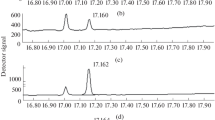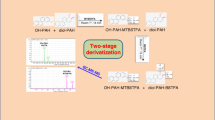Abstract
Alkoxyacetic acids are metabolically formed and excreted in urine after exposure to ethylene glycol monoalkyl ethers (alkoxyethanols) or their acetate esters. This paper presents a sensitive method based on extractive alkylation for determination of alkoxyacetic acids in urine. Alkoxyacetate ions were extracted from 200 μl urine into methylene chloride, with tetrabutylammonium acting as counter ion, and derivatized with pentafluorobenzyl bromide in a single step. After separation of the methylene chloride phase, evaporation, and dissolution of the residues in hexane the esters were analyzed by fused silica capillary column gas chromatography and electron capture detection. The esters formed were stable for at least 2 weeks at room temperature. The limit of quantification was estimated to 2 μM (corresponding to an injected amount of 2 pg) for methoxyacetic (MAA) and ethoxyacetic acid (EAA) in urine. The corresponding values for butoxyacetic acid (BAA) were 4 μM and 5 pg, respectively. The detector response was linear up to 80 μM and the formation of derivative at least up to 1 mM. The method error may be reduced by using a second alkoxyacetic acid derivative, EAA, BAA or 2-pentoxyacetic acid (PAA), as an internal standard. The sensitivity, stability, reduced number of extractions, and small volumes of reagents and sample needed make the present method useful in biomonitoring of occupational exposure to ethylene glycol ethers.
Similar content being viewed by others
References
Bartnik FG, Reddy AK, Klecak G, Zimmermann V, Hostynek JJ, Kunstler K (1987) Percutaneous absorption, metabolism, and hemolytic activity of n-butoxyethanol. Fund Appl Toxicol 8: 59–70
Carpenter CP, Pozzani UC, Weil CS, Nair JH, Keck GA, Smyth HF Jr (1956) The toxicity of butyl cellosolve solvent. Arch Ind Health 14: 114–131
Cheever KL, Plotnick HB, Richards DE, Weigel WW (1984) Metabolism and excretion of 2-ethoxyethanol in the adult male rat. Environ Health Perspect 57: 241–248
Clapp DE, Smallwood AW, Moseley C, DeBord KE (1987) Workplace assessment of exposure to 2-ethoxyethanol. Appl Ind Hyg 2: 183–187
Dugard PH, Walker M, Mawdsley SJ, Scott RC (1984) Absorption of some glycol ethers through human skin in vitro. Environ Health Perspect 57: 193–197
Ghanayem BI, Burka LT, Sanders JM, Matthews HB (1987) Metabolism and disposition of ethylene glycol monobutyl ether (2-butoxyethanol) in rats. Drug Metab Dispos 15: 478–484
Groeseneken D, Van Vlem E, Veulemans H, Masschelein R (1986a) Gas chromatographic determination of methoxyacetic and ethoxyacetic acid urine. Br J Ind Med 43: 62–65
Groeseneken D, Veulemans H, Masschelein R (1986b) Urinary excretion of ethoxyacetic acid after experimental human exposure to ethylene glycol monoethyl ether. Br J Ind Med 43: 615–619
Groeseneken D, Veulemans H, Masschelein R, Van Vlem E (1987) Ethoxyacetic acid: a metabolite of ethylene glycol monoethyl ether acetate in man. Br J Ind Med 44: 488–493
Illing HPA, Tinkler JJB (1985) Toxicity Reviews 10. Glycol ethers. Her Majesty's Stationery Office, London (ISBN 0-118-83807-5)
Johanson G, Fernström P (1986) Percutaneous uptake rate of 2-butoxyethanol in the guinea pig. Scand J Work Environ Health 12: 499–503
Johanson G, Kronborg H, Näslund PH, Byfält Nordqvist M (1986) Toxicokinetics of inhaled 2-butoxyethanol (ethylene glycol monobutyl ether) in man. Scand J Work Environ Health 12: 594–602
Johanson G, Boman A, Dynésius B (1988) Percutaneous absorption of 2-butoxyethanol in man. Scand J Work Environ Health 14: 101–109
Johanson G, Michel I, Norbäck D, Nise G, Tillberg A (1989) Biological monitoring of exposure to ethylene glycol ethers. Arch Toxicol (in press)
Jönsson A-K, Steen G (1978) n-Butoxyacetic acid, a urinary metabolite from inhaled n-butoxyethanol (butylcellosolve). Acta Pharmacol Toxicol (Copenh) 42: 354–356
Jönsson A-K, Pedersen J, Steen G (1982) Ethoxyacetic acid and N-ethoxyacetylglycine: metabolites of ethoxyethanol (ethylcellosolve) in rats. Acta Pharmacol Toxicol (Copenh) 50: 358–362
Lowry LK (1987) The biological exposure index: its use in assessing chemical exposures in the workplace. Toxicology 47: 55–69
Smallwood AW, DeBord KE, Lowry LK (1984) Analyses of ethylene glycol monoalkyl ethers and their proposed metabolites in blood and urine. Environ Health Perspect 57: 249–253
Veulemans H, Groeseneken D, Masschelein R, Van Vlem E (1987) Field study of the urinary excretion of ethoxyacetic acid during repeated daily exposure to the ethyl ether of ethylene glycol and the ethyl ether of ethylene glycol acetate. Scand J Work Environ Health 13: 239–242
Author information
Authors and Affiliations
Rights and permissions
About this article
Cite this article
Johanson, G. Analysis of ethylene glycol ether metabolites in urine by extractive alkylation and electron-capture gas chromatography. Arch Toxicol 63, 107–111 (1989). https://doi.org/10.1007/BF00316431
Received:
Revised:
Accepted:
Issue Date:
DOI: https://doi.org/10.1007/BF00316431




